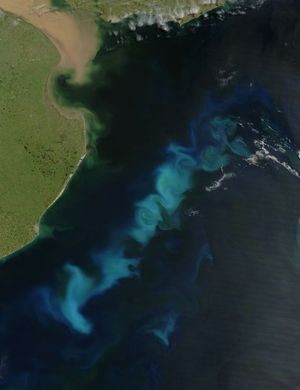Seeing Algal Blooms from Space - Planet Earth Online
Interview with
Kat - Phytoplankton are the smallest organisms in the sea. These tiny little plants provide the base of the food chain for marine life and they generate energy by harvesting the power of sunlight using chlorophyll and drawing CO2 out of the atmosphere. Although they may be very small, they can still be studied from space. Planet Earth podcast presenter Sue Nelson has been speaking to Earth Observation Scientist Peter Miller from the Plymouth Marine Laboratory.
Peter - Chlorophyll and plankton are individually microscopic. However, when they  are in massive numbers and concentrations they tint the water to the shade of green that we're familiar with and that is what we can detect from satellites. We can see how green the water is from space and, with algorithms, we can convert that into a measure of the chlorophyll and hence the amount of plankton in the water.
are in massive numbers and concentrations they tint the water to the shade of green that we're familiar with and that is what we can detect from satellites. We can see how green the water is from space and, with algorithms, we can convert that into a measure of the chlorophyll and hence the amount of plankton in the water.
Sue - Now why do you want to know how much plankton is in the water?
Peter - Because plankton is so important for the carbon cycle and for other marine life, it is very important that we know where it is growing, how that is changing in our changing climate, if there is any migration of the plankton further north with warmer seas and if there is change in the types of plankton that is growing. It is a good measure of how healthy the ocean is.
Sue - Why use a satellite for this when you could maybe just use a research ship?
Peter - The satellites give us a wonderful coverage of the ocean, almost globally every day. So depending on the cloud cover, we can see through to the ocean and build up a picture of every part of the ocean on a daily timescale. That allows us to follow the progression of blooms, we can see the seasonal cycle, we can monitor for particular blooms that might be of interest like harmful algae.
Sue - Most algae blooms, like the one 50 miles long off the coast of Devon and Cornwall earlier this year, are both natural and benign and they are also an important food source, but can some blooms can be a problem?
Peter - It is only particularly dense blooms that can be a problem. When dense blooms decay, the bacteria can consume all of the oxygen in the water - usually in the deeper part of that ocean, so it is there that the bloom can have a significant effect on the marine life. Certain types of algae, under certain conditions, can produce toxins, poisonous substances that get released into the water. When they are consumed by shellfish, for instance, they can get concentrated and it is very bad news if humans eat those poisonous shellfish.
Sue - Can you tell purely from satellite data whether a bloom is harmful or not by its colour?
Peter - This is what we're studying under a European project called AquaMar and within that, we are trying to develop our tools for assessing particular characteristic colours that certain blooms indicate when they are harmful. We are studying the whole archive of data and we are picking out examples of blooms that were harmful and we're then trying to classify new satellite images to see if they are similar in colour to those known blooms.
Sue - What can this sort of information be used for then?
Peter - It is very important for the aquaculture industry. They need to know if harmful blooms are going to affect their fish farms or shellfish. It is important for the authorities that deal with bathing water because it may be something that they need to warn the public about when it happens. It can also be important for climate change studies. We need to know if certain kinds of harmful algae blooms are going to occur more frequently with the change in climate.
Sue - And when do you think you will be in a position to actually produce an algal bloom early warning system?
Peter - We have got prototype systems that we have worked on with the Environment Agency in the UK and we are now testing them around Europe. I should say that this work is based upon our national capability which is the NERC Earth Observation Data Acquisition and Analysis Service (NEODAAS) service that provides us with the core capability to process huge quantities of satellite images every day and very quickly so that if a bloom does happen, we can provide detailed information the same day that we get the satellite image.
Kat - That was Peter Miller from the Plymouth Marine Laboratory, talking to Sue Nelson about a possible early warning system for algal blooms.










Comments
Add a comment